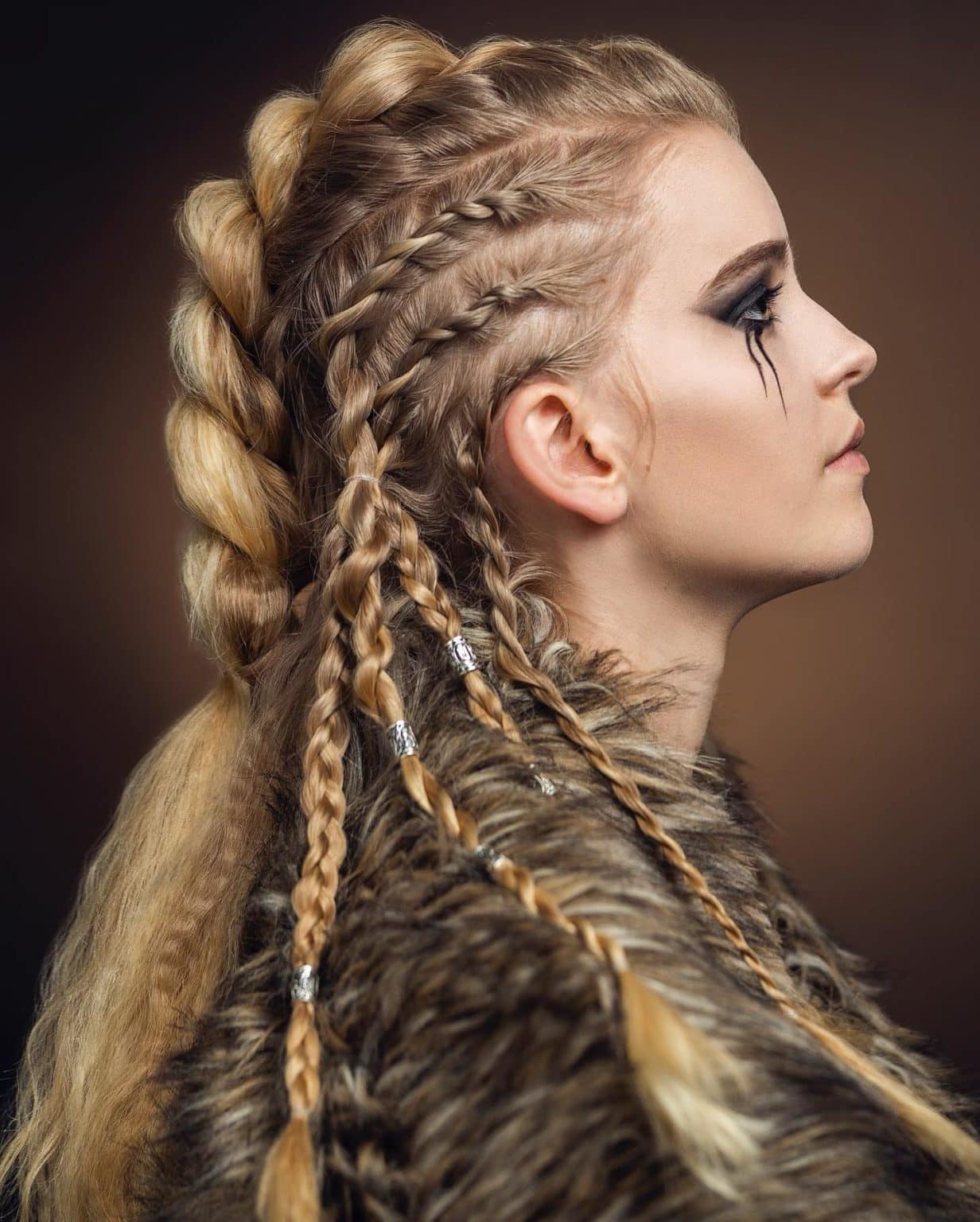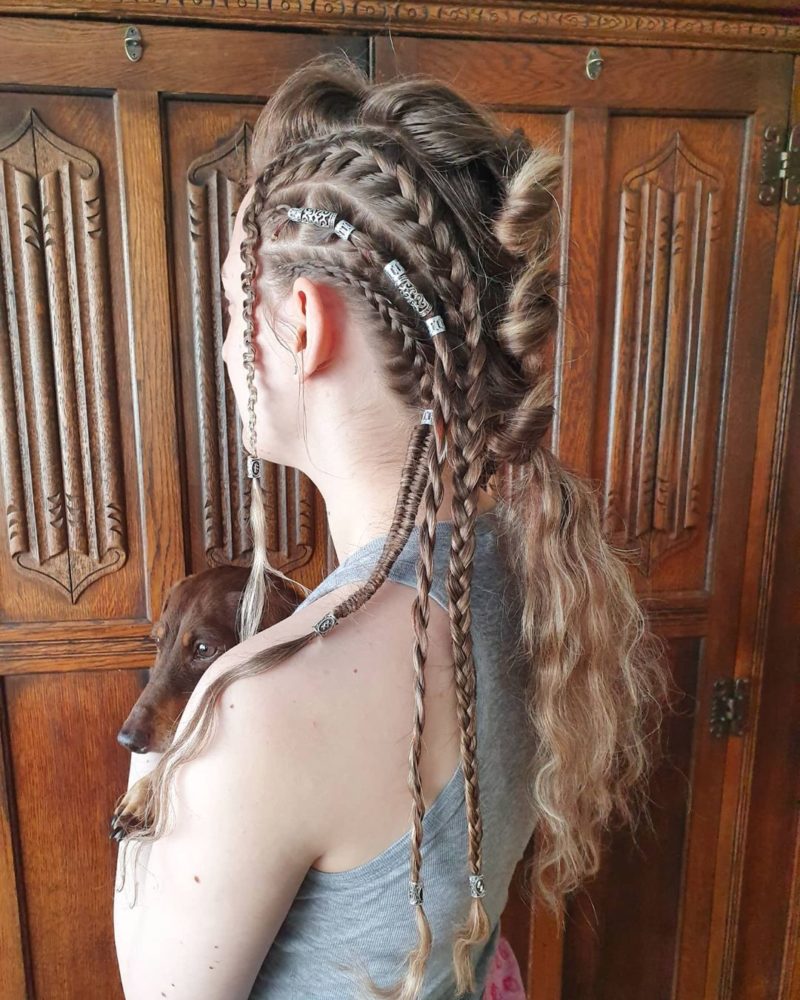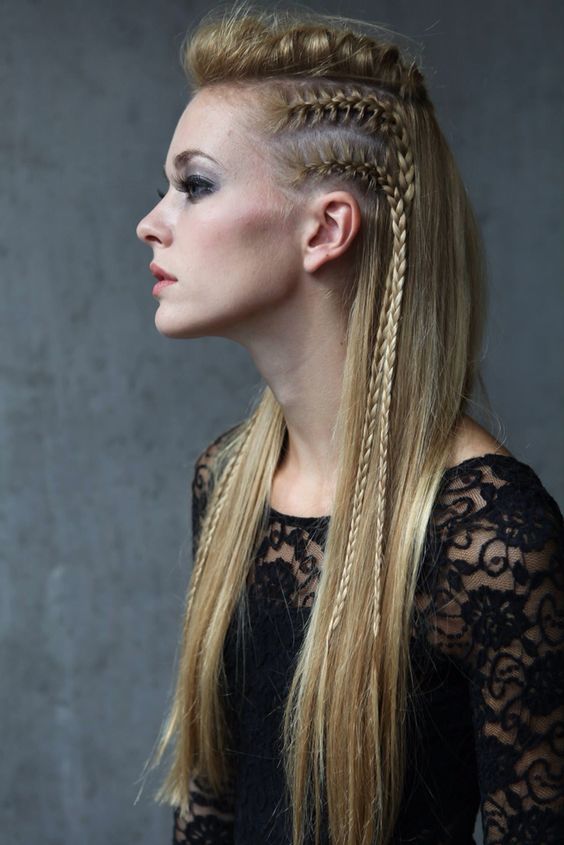For quite some time now, a particular hair fashion has really captured people's attention, drawing inspiration from old stories and television shows. It's that rugged, yet very refined, look often seen on characters who seem to embody raw strength and a connection to a bygone era. This way of styling hair, you know, it just feels like it has a story to tell, something about courage and a life lived close to the land.
People are finding a real draw to these hair patterns, perhaps because they bring a sense of history right into everyday life. It’s a way to feel a bit more connected to those who lived long ago, those folks who built impressive ships and traveled far across the water. This style, actually, it seems to carry with it a whisper of ancient traditions, a feeling of something passed down through many, many generations.
So, we're going to take a closer look at these interesting hair designs. We'll explore where they might have come from, what they could have meant to the people who first wore them, and how you might even create some of these looks yourself with what's available today. It’s all about understanding a bit more about this striking hair trend and its deep roots.
- Wilmington Trust
- Las Lomas
- The Waldorf Hilton London London
- Butternut Ski Great Barrington
- Who Does Ronaldo Play For
Table of Contents
- The Enduring Charm of Viking Braids
- Did Ancient Vikings Really Wear Braids?
- What Did Historical Evidence Show About Viking Braids?
- How Did Hair Show a Person's Place in Viking Society?
- Can You Create Your Own Viking Braids Today?
- The Modern Comeback of Viking Braids
The Enduring Charm of Viking Braids
There's something truly captivating about the look of braided hair, especially when it calls to mind the people of the ancient North. This particular style, which has become very popular in recent times, seems to hold a special appeal. It often features two distinct plaits on either side of the head, sometimes blending into a larger, more intricate pattern at the back. It’s a style that, in some respects, feels both strong and very artistic, too.
People who choose this kind of hairstyle often find it gives them a certain kind of presence. It’s a way to present oneself that feels rather powerful, almost like a leader from a storybook. This look, you know, it can really change how someone appears, making them seem quite formidable and ready for anything. It’s a hair choice that suggests a person with a good deal of inner fortitude.
Beyond just looking good, these hair designs seem to carry a deeper meaning for many. They are seen as a way to connect with qualities like resilience, the ability to bounce back from tough times, and even a certain inventiveness that people associate with the old Norse folk. It’s a way, actually, to feel a bond with those who lived long, long ago, long after their great ships sailed for the last time. This style is, in a way, a piece of history that has come down to us through many centuries.
- Nobu Houston
- Willow Creek Theater
- Hyderabad Airport International
- Boyne Mountain Michigan
- Soldier Hollow Golf
The beauty of this particular hair arrangement is how it manages to be both straightforward and quite elaborate at the same time. The woven sections are certainly the main focus, the part that truly stands out. However, the rest of your hair often flows freely, creating a lovely contrast. This mix, you know, it just works really well, offering a look that is both striking and somewhat relaxed.
Did Ancient Vikings Really Wear Braids?
A question that often comes up is whether the people we call Vikings truly wore the elaborate, braided hairstyles we see in popular entertainment. It’s a fair thing to wonder, especially when television shows present such striking images. These shows, like that one about the Vikings, have certainly made these hair designs very well-known, causing many to think of them as a standard look from that time. So, was this really the case, or is it more of a modern artistic choice?
To put it simply, yes, some of the old Norse people did wear braided hair. However, it’s probably fair to say that the styles they wore weren't exactly like those shown by the actors on screen. Those on television are often a bit more dramatic, perhaps, or more complex than what was typically seen in everyday life back then. It’s a matter of looking at what evidence we have from that time, which can tell us a bit more about what was truly common.
When we look at the historical records, it appears that while braids were a part of hair fashion, they might not have been the most common choice for everyone. In fact, many of the old Norse warriors, the ones we often picture with long, wild hair, usually kept their hair quite short. This means that, in reality, braided hair might have been a bit less common than we generally imagine. Other ways of styling hair were also present in their way of life.
What Did Historical Evidence Show About Viking Braids?
When we try to figure out what hair looked like in the old Norse lands, we usually look at a few key things. We examine statues, carvings, and even old written accounts that have survived through the ages. These pieces of history, you know, they give us little glimpses into the daily lives and appearances of people from that time. They are, in a way, like snapshots from a very distant past.
From what these old objects and texts suggest, it seems that for many Norse fighters, their hair was kept fairly short. This makes the idea of widespread, very long braids a bit less likely for the general population, especially for men who were often in battle. It’s possible that practical reasons, like keeping hair out of the way during fights, played a part in this. So, while some may have had longer hair, it appears shorter styles were quite common for a lot of people.
However, it’s also important to note that some people, especially younger women, may have worn their hair in braids. These might have been simpler plaits, perhaps, rather than the very elaborate, interwoven patterns we sometimes see depicted. The evidence points to a range of hair choices, not just one single, popular style. The idea that everyone had very long, intricate viking braids might be more of a modern interpretation than a historical fact.
The history of hair styling is a very rich subject, and it makes you wonder if the Norse people were truly the first to come up with this timeless hair design, or if its origins lie somewhere else entirely. Hair braiding, after all, has been around for a very long time in many different parts of the world. So, it's almost a good question to ask whether the Norse truly pioneered this look, or if they adopted it from others. It’s a bit of a mystery, actually, how these styles truly spread across different groups of people.
How Did Hair Show a Person's Place in Viking Society?
Hair, for people in ancient times, was often more than just something to keep tidy. It could be a powerful way to show who you were, what group you belonged to, and even your standing in the community. For the Norse people, their hair could very well have reflected their background, their personal identity, and where they fit into the social structure. It was, in a way, a visual cue for others to see.
The way someone styled their hair, including the use of braids, might have sent messages without a single word being spoken. Perhaps a certain type of braid, or the lack of one, could indicate if someone was married, if they were a warrior, or if they held a position of respect. These sorts of details were, in some respects, a kind of unspoken language that everyone understood. It’s interesting to think about how much information a simple hairstyle could convey back then.
This idea of hair as a symbol isn't unique to the Norse, of course. Many old groups of people, like the ancient Celts, also had strong traditions around hair. It’s worth noting that these braided styles were popular among both the old Celts and the Norse. This suggests a shared appreciation for certain looks, or perhaps even a common source for some of these hair ideas. The way hair was kept could signify a lot about a person’s life and their connections.
People today, you know, they really embrace these hair designs as a way to feel a bond with the qualities of the old Norse people. They see it as a way to connect with the strength, the ability to endure, and the cleverness that these historical figures are known for. It’s a very personal way to feel a link to a past that still resonates with many. This way of styling hair becomes a kind of bridge between then and now, a way to carry a piece of history with you.
Can You Create Your Own Viking Braids Today?
If you're interested in trying out these striking hair looks, the good news is that you absolutely can. Modern tools and styling products make it much easier to recreate these ancient-inspired designs. You don't need to live in a longhouse or sail a great ship to sport a look that calls to mind those rugged people of the North. It's almost surprising how accessible these styles have become for anyone who wants to try them.
One of the most recognizable styles involves braids that can be quite simple, like a single plait, or much more involved, with many strands woven together in complex patterns. The beauty of these looks is that you can pick a style that suits your skill level and your own hair. You might start with something straightforward and then, perhaps, move on to something more challenging as you get the hang of it. It’s all about finding what works for you.
For those eager to learn how to make these stunning plaits, there are plenty of resources available. You can find guides that will walk you through the steps, helping you understand the techniques needed. Whether you have long hair, short hair, or are looking for something for a woman or a man, there are ways to adapt these styles. It’s all about getting a little bit of practice, and you'll be able to create some impressive looks.
Even if you have shorter hair, you can still achieve a look inspired by these old styles. Sometimes, it involves just braiding smaller sections, or using styling products to create the impression of a more elaborate look. The key is to get creative and work with what you have. For some styles, a good styling product is quite helpful to keep everything neatly in place throughout the day. It helps the hair stay put, you know, so your hard work doesn’t come undone too quickly.
The Modern Comeback of Viking Braids
These days, these old-fashioned hair designs are truly making a big return. You see them not just on fashion models walking down runways or at gatherings of people who love history. Instead, they’ve become a vibrant way for everyday people to show a little appreciation for those tough, brave people from the North. It’s a fascinating trend, actually, how something so old can feel so new and fresh again.
Television shows have played a very big part in bringing these hair styles back into the public eye. That popular show about the Vikings, for instance, has certainly made these looks much more widely known. Characters like Bjorn, with his distinctive hair, have become a prime example of what many consider to be a truly cool Nordic look. His hair, you know, it just seems to capture that spirit perfectly, making people want to try something similar.
This resurgence is about more than just fashion; it’s about a feeling. It’s about connecting with a sense of strength and a certain kind of untamed beauty. People are drawn to the idea of a style that feels both ancient and very current. It’s a way to add a bit of character to one’s appearance, a subtle nod to a powerful past. The appeal, in some respects, is quite deep, going beyond just what looks good.
So, we've looked at the enduring charm of these braided styles, questioned how common they truly were in ancient times, explored what historical evidence tells us, and considered how hair might have shown a person's place in old Norse society. We also discussed how you can create these looks today and the reasons behind their popularity now. It's clear that these hair designs, whether historically accurate or inspired by stories, continue to hold a special appeal for many people.
Related Resources:



Detail Author:
- Name : Mr. Hayley Keeling Jr.
- Username : tara62
- Email : raynor.keara@treutel.com
- Birthdate : 1988-11-20
- Address : 98785 Carmella Cove Nicolasville, ME 57137-1631
- Phone : (713) 806-5646
- Company : O'Reilly, Skiles and Will
- Job : Diesel Engine Specialist
- Bio : Occaecati quia est voluptatum laborum nobis culpa ab. Aut illum inventore commodi earum optio. Nihil ut totam accusamus numquam.
Socials
facebook:
- url : https://facebook.com/valentinepowlowski
- username : valentinepowlowski
- bio : Iste dolorem minus sequi porro aliquam. Voluptatem asperiores minus cum eum.
- followers : 2290
- following : 1408
tiktok:
- url : https://tiktok.com/@valentine161
- username : valentine161
- bio : Temporibus nobis et molestiae sint aut.
- followers : 762
- following : 1523
twitter:
- url : https://twitter.com/valentine_official
- username : valentine_official
- bio : Expedita labore dolores ut delectus voluptatem esse. Ea saepe minima aut perferendis vel. Deserunt optio ut labore rerum voluptatem asperiores distinctio.
- followers : 3854
- following : 2128
linkedin:
- url : https://linkedin.com/in/powlowski1986
- username : powlowski1986
- bio : Aut minus veritatis mollitia quo sed sunt.
- followers : 2499
- following : 1142